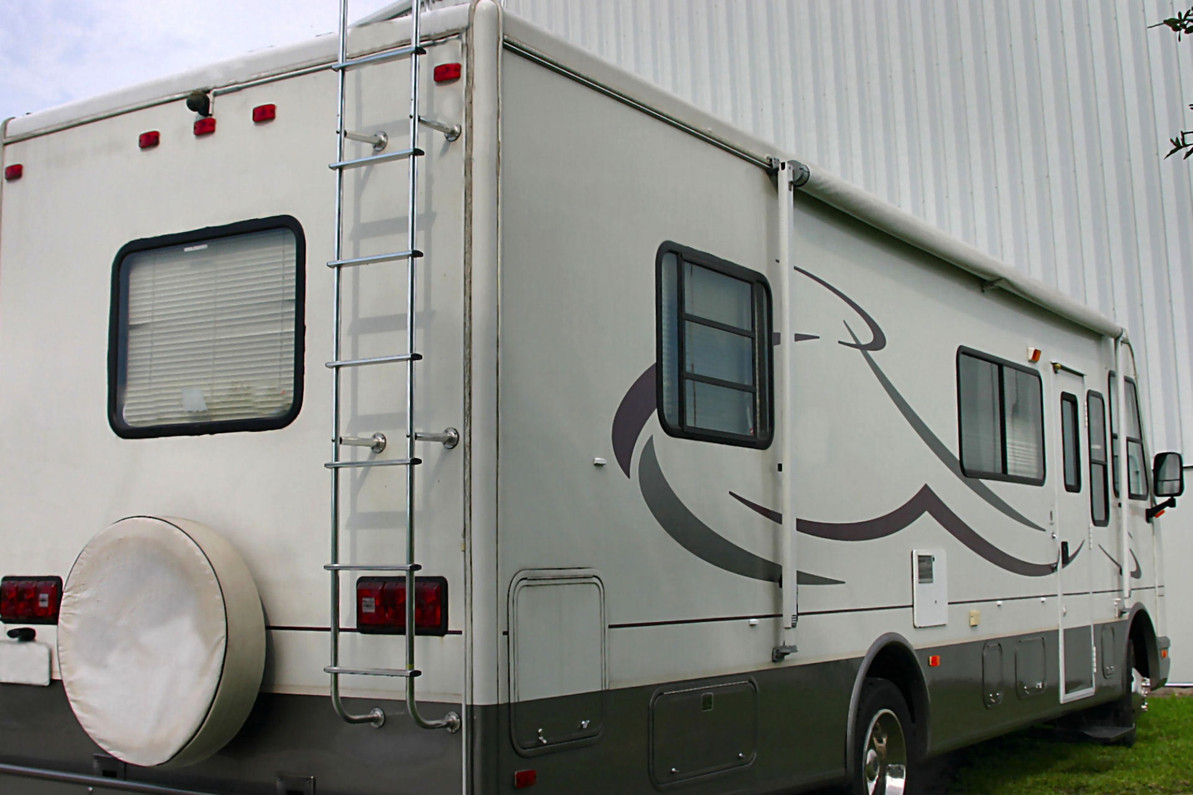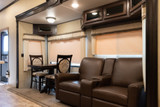What's the Deal With RV Ladders?
Chances are you have been driving on the road and passed an RV with a ladder mounted on the back. It doesn’t seem like a very safe place to hang out, so why the need for a ladder? In this article, we will examine the reasons for having an RV ladder and what types are available.
What is the purpose of an attached RV ladder?
RVs with attached ladders on the back typically have some sort of rooftop appliance, but not always. The ladder is installed by the manufacturer to make it easy to access the roof for regular maintenance and cleaning of the roof and rooftop accessories.
It is usually safe to assume that the roof of an RV with an attached ladder is strong enough to walk on, but factors such as the age and state of the roof, as well as the weight of aftermarket rooftop accessories, should be considered.
Some RVs, typically those that have been converted from some other type of vehicle, have a rooftop deck. An aftermarket attached ladder may be installed for use in these cases but rarely is installed by a manufacturer. Rooftop decks are not very common due to difficulty in finding insurance for vehicles with this feature.
Ladder-Mounted Equipment Rack
In addition to providing rooftop access, mounted RV ladders can serve an additional purpose in hauling equipment. Ladder-mounted bike and chair racks can provide a space-saving solution allowing you to bring more with you on the road. With ladder-mounted equipment racks, it is good practice to inspect the rack and re-secure it if necessary before every trip.
What type of RV ladders are available?
There are a multitude of styles and sizes of RVs available on the market today. With that comes the need for various ladders to accommodate interior layouts and exterior features of everything from motorhomes to travel trailers to toy haulers. We discussed the need for easy rooftop access in rigs with rooftop accessories, but there are other cases where a ladder may be needed in an RV. Keep reading to learn more about the common types of RV ladders available and the purposes they serve.
Fixed RV Roof Ladder
A fixed RV roof ladder is permanently mounted to the rear exterior of the RV to provide quick and easy access to the roof. Large class A motorhomes will commonly come with a fixed roof ladder direct from the manufacturer. Regular roof cleaning and maintenance of rooftop appliances, such as an air conditioner, require frequent access, so a mounted ladder simplifies that process for RV owners. It is also fairly common to see fixed roof ladders on campervans and Overlanding vehicles. Rooftop access is typically associated with camping and roof-mounted tents or decks in these cases.
Collapsible Exterior Ladder
This type of ladder is similar to the traditional fixed RV roof ladder style but offers the ability to fold up when not in use to lay flat against the exterior. Collapsible exterior ladders are permanently mounted for sturdy support and feature locking hinges to extend the ladder down and out from the RV, so there is space for climbing. These ladders provide the same utility as fixed roof ladders in terms of easy access to the roof without adding excess length to your rig.

RV Bunk Ladder
Lofted bed floorplans are typical in class C motorhomes, fifth-wheels, and toy haulers. These styles often feature a sleeping area above the driver’s compartment or over the bed of the towing vehicle. These layouts are a great way to provide extra living areas by utilizing otherwise wasted vertical space. In order to reach these lofted areas, a ladder is typically the best choice. Bunk ladders will usually have a hook design so that the ladder is sturdy for climbing but does not have to be permanently mounted. In smaller vehicles with bunk space, an adjustable height step stool may also be adequate and require less storage space.
Telescoping Ladder

Telescoping ladders provide a versatile, space-saving option for RVers. These ladders are designed so that each rung extends up individually from the previous rung. A telescoping ladder can be set to various heights as each rung is also equipped with its own locking mechanism. When the ladder is not in use, it collapses straight down as the rings slide into a contained pile.
With traditional ladders, storage is difficult as they are not collapsible, and you may need to carry around multiple sizes for various applications. The telescoping mechanism eliminates or significantly reduces these issues, though it represents a new safety hazard. The structure of a telescoping ladder relies solely on the locking mechanisms holding the extended rungs in place. Misuse or neglect of these mechanisms can result in a serious fall. With telescoping ladders, it is crucial to keep them in good working condition and regularly inspect the unit before use.
Luckily, telescoping ladders take up very little storage space. This means you can avoid weather damage and UV stress by storing your ladder inside when not in use. Keeping your ladder dry and out of direct sunlight will help to preserve its usability.
How do I determine the quality of an RV ladder?
The quality of a ladder is important to your safety and often determines the length of lifetime use. Poor quality materials and manufacturing can result in a ladder that is not sturdy, uncomfortable or slippery to stand on, and prone to weather damage. When choosing a ladder, you should consider the following.
Material

Most RV ladders will be made from some sort of metal or composite material. Aluminum is the most common due to its high strength-to-weight ratio and low cost. Fiberglass is an alternative lightweight option that may be more expensive but provides better weather-resistant properties.
Height
Verify the maximum height you will need to reach using your ladder. You don’t want a ladder that is too short because that would defeat the entire purpose. On the other hand, you don’t want a ladder that is too long either. If you anticipate needing a ladder for a variety of purposes, telescoping ladders provide the most variation in heights for a single ladder.
Weight
The weight of a ladder doesn’t necessarily offer any insight into its quality, but it’s helpful to consider for your own sake. A lightweight ladder will be easier to carry around than a heavy-duty one and can provide much of the same utility for RV owners.
Load Capacity
The load capacity refers to the total amount of weight the ladder can safely support. This can vary between ladders depending on the intended use. Light duty ladders are rated for 200 pounds, while extra heavy duty ladders are rated for 375 pounds.
We want to hear what you think! Comment your thoughts or questions below!
Recent Posts
-
Traveling to the RV Hall of Fame in Elkhart, IN
If you are traveling to Elkhart, IN to see the RV Hall of Fame, getting off the toll road at exit 96 …Nov 14, 2025 -
Best RV Air Conditioners of 2025: An Expert Guide From RecPro
Quick Answers Best overall RV air conditioner: RecPro 15K Quiet AC with Heat Pump (RP-AC3800) Best f …Oct 29, 2025 -
The Nuclear Nomads Expand Sofa with New Recliner Section Install
The Nuclear Nomads are a full time RV family living in south Florida. Andi and Joey value quality ti …Oct 24, 2025 -
Trailer Wiring Guide: How to Wire Your Trailer for Safety and Efficiency
Table of Contents 1. Common Types of Trailer Connectors 2. Trailer Wiring Diagrams: Color Codes and …Aug 20, 2024 -
How to Keep Your Pets Safe While Camping
RVing and camping are a great getaway from the hustle and bustle of work and the city and the day-to …Jul 02, 2024 -
Why Replace Your RV Furniture?
You may wonder when is the best time to replace your RV furniture. There is no one right answer to t …May 20, 2024







